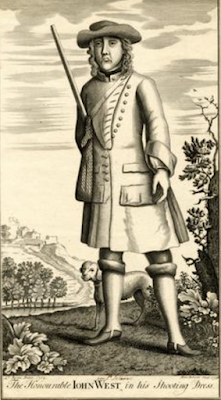The founder of this family, SIR THOMAS WEST, Knight, lived in the reign of EDWARD II, and was in high favour with that monarch and his successor. He married Eleanor, daughter and heiress of Sir John de Cantilupe, of Hempston Cantilupe, Devon, by whom he obtained the manor of Snitterfield, in Warwickshire. Sir Thomas was subsequently summoned to parliament as Baron West in 1342, and participated in the wars of EDWARD III.
Sir Thomas died in 1342, and was succeeded by his son,
THOMAS, 2nd Baron, who was not summoned to parliament, though served at Crécy in 1346.
His son,
THOMAS, 3rd Baron, was summoned to parliament in 1402; and dying three years later, in 1405, was succeeded by his son,
THOMAS, 4TH BARON, who took a distinguished part in the French wars of HENRY V.
Dying without issue, in 1415, he was succeeded by his brother,
REGINALD, 5TH BARON, who, in the reign of HENRY VI, on the death of Thomas, Lord la Warr, his uncle, had livery of the lands of his mother's inheritance, and was summoned to parliament as 6th Baron De La Warr, on the death of his uncle in 1426.
Dying in 1451, he was succeeded by his son,
RICHARD, 7th Baron, a staunch supporter of the house of LANCASTER in the war of the Roses.
Following his decease in 1497, he was succeeded by his son,
THOMAS, 8th Baron (c1457-1525), KG.
His lordship's lineal descendant,
WILLIAM WEST, having served in the English army, at the siege of St Quintin, in Picardy, was knighted at Hampton Court in 1568; and created, at the same time, Baron De La Warr (2nd creation).
He had also, by act of parliament, a full restitution in blood. His only son,
THOMAS, 2nd Baron, was succeeded by his son,
THOMAS, 3rd Baron (1577-1618), Governor and Captain-General of Virginia.
THE STATE of Delaware takes its name from Thomas West, 3rd Baron De La Warr. In the United States, Thomas West, 3rd (or 12th) Baron, is often named in history books simply as Lord Delaware. He served as governor of the Jamestown Colony, and the Delaware Bay was named after him.
The state of Delaware, Delaware River and Delaware Indians were so called after the bay, and thus ultimately derive their names from the barony. Many other US counties, townships and the like derive their names directly or indirectly from this connection.
His lordship died, in 1618, at Virginia and was succeed in the title by his son,
HENRY, 4th Baron; whose grandson,
JOHN, 6th Baron, one of the tellers of the exchequer, and afterwards treasurer of the excise, married and was succeeded by his only son,JOHN, 7th Baron (1693-1766), KB, PC,
Lieutenant-general in the Army, Seventh Royal Governor of New Jersey, Colonial Governor of New York, Governor of Gravesend and Tilbury, Governor of Guernsey.
His lordship marred twice, firstly to Lady Charlotte, daughter of the Earl of Clancarty.
In 1761 this nobleman was created Viscount Cantelupe and EARL DE LA WARR.
He died in 1766 and was succeeded by his eldest son,
JOHN, 2nd Earl, was an officer of high rank in the army and appointed, in 1766, Master of the Horse to The Queen.
William Herbrand [Sackville], 11th Earl De La Warr, is seated at Buckhurst Park, Withyham, Sussex.
Former town residence ~ 14 Bourne Street, London.
First published in June, 2012. Coat-of-arms courtesy of European Heraldry.
 |
| John, 1st Earl de la Warr (Print: The British Museum) |
In 1761 this nobleman was created Viscount Cantelupe and EARL DE LA WARR.
He died in 1766 and was succeeded by his eldest son,
JOHN, 2nd Earl, was an officer of high rank in the army and appointed, in 1766, Master of the Horse to The Queen.
*****
William Herbrand [Sackville], 11th Earl De La Warr, is seated at Buckhurst Park, Withyham, Sussex.
Former town residence ~ 14 Bourne Street, London.
First published in June, 2012. Coat-of-arms courtesy of European Heraldry.



1 comment :
On 6 November 1890 Viscount Cantelupe,a son of one of the de la Warrs, was drowned at Bangor Co. Down when his large yacht 'Urania' was wrecked in a gale. The remaining five crew were all saved by breeches buoy. The spot is just off the present Seacliff Road, on the Bangor side of the point You will find a long report in the Belfast press.
Post a Comment